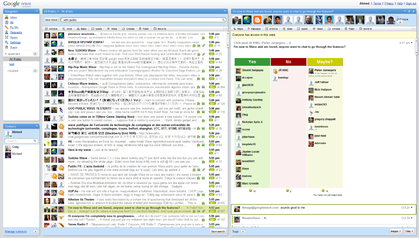Email may be one of the most popular communication platforms there has ever been, but that doesn’t stop people thinking it is some kind of problem that needs to be fixed.
Google’s Inbox is the latest attempt to turn email on its head. Not content with virtually having the webmail market sewn up with Gmail, Google have sought to rethink it as well.
This is all part of Google’s strategy of having two of everything. Whether it finds itself in a dominant position or not, it seeks to create competition within itself in the quest for continuous improvement.
The last time Google tried this they came up with with Google Wave, a confusing mess of an app that was retired after a few months. Reviews for Inbox have generally been much better. But I can’t help but feel just as confused by it.
The quest for continuous improvement is a laudable part of human nature. But most attempts to “fix” email ultimately end up being confusing — at least to me.
Last year Gmail provided the first hint that Google’s email offering was heading in this direction when it introduced its tabbed categories layout. This automatically organised emails into separate sections for social, promotions and updates. The problem was that I did not trust it one bit and I switched the option off very quickly.
Inbox is a similar idea, but much more extreme. Emails are automatically arranged into ‘bundles’ for travel, purchases, finance, social, updates, forums and promos.
To me, this is just adding cognitive overhead. If my phone pings with a notification then I check Inbox on my computer, I am presented first with the bundles. It is not immediately clear which emails have been read and which have not.
Worse still, the automatic rearrangement of my emails is still not reliable. To take one example, emails about a change in PayPal’s policy appear under purchases. Why would these not appear under finance? Meanwhile, looking into the forums bundle reveals emails from my bank and updates from a political party.
Even if I liked the principle of organising emails in this way (which I don’t), it simply doesn’t work. I am not sure we are ready to entrust the prioritisation and categorisation of email to algorithms yet.
There are all sorts of things I am happy to let algorithms take control of. For instance, I tolerate the wrong suggestions Google Now often comes up with, because it’s worth it for the ones that are right. You can always just swipe the wrong ones away.
Email can be a bit more critical than that though. If an email is automatically bundled away in an obscure place without you knowing, you might miss some important messages.
It may get better over time, as people have told me. But why should I spend time teaching Inbox how to put emails in bundles that I don’t want?
Google Now works because it uses data that I have given Google anyway. I don’t need to do anything special. It literally just works.
In contrast, Inbox forces me to change the way I work with email in order for it to become remotely reliable. The learning curve is steep.
Mercifully, it is possible to switch bundles off. But confusion remains nevertheless.
What, for instance, distinguishes an email that is done from one that has been read? Or from one that has been pinned and then unpinned? It took me a while to realise that emails I had marked as done on my phone also remained marked as unread.
The option to snooze an email is an interesting one, but not one that has come in handy for me yet (despite me trying it out).
Inbox is a product of solutions looking for a problem.
Beyond the complicated features, Inbox looks and feels nice to use. But after a week of using it I still can’t get my head around why I am even supposed to want this. I would rather have a material design version of Gmail.
I am told that what makes Inbox great is that it pushes you towards inbox zero, the glorious situation where you have no unread email.
The thing is, I have never had any trouble reaching and maintaining inbox zero.
For me, the most efficient way of dealing with email is to deal with it as it comes in and either mark it as read or star/pin/flag it for action later. That way, I know I won’t miss anything (unless a legitimate email ends up in the spam folder, which is increasingly uncommon).
I don’t see the need to make email any more complicated than that.

